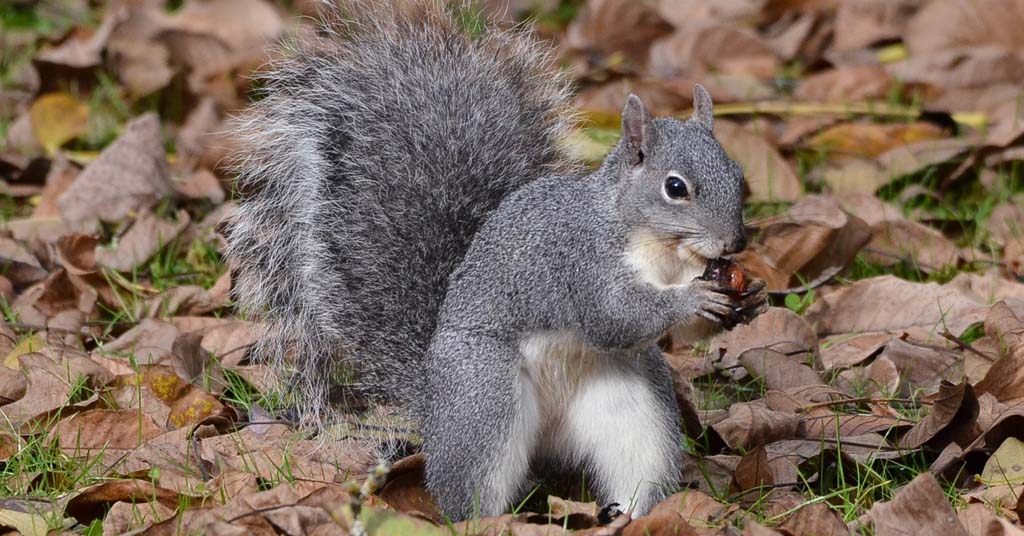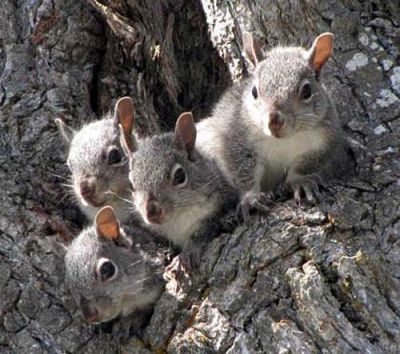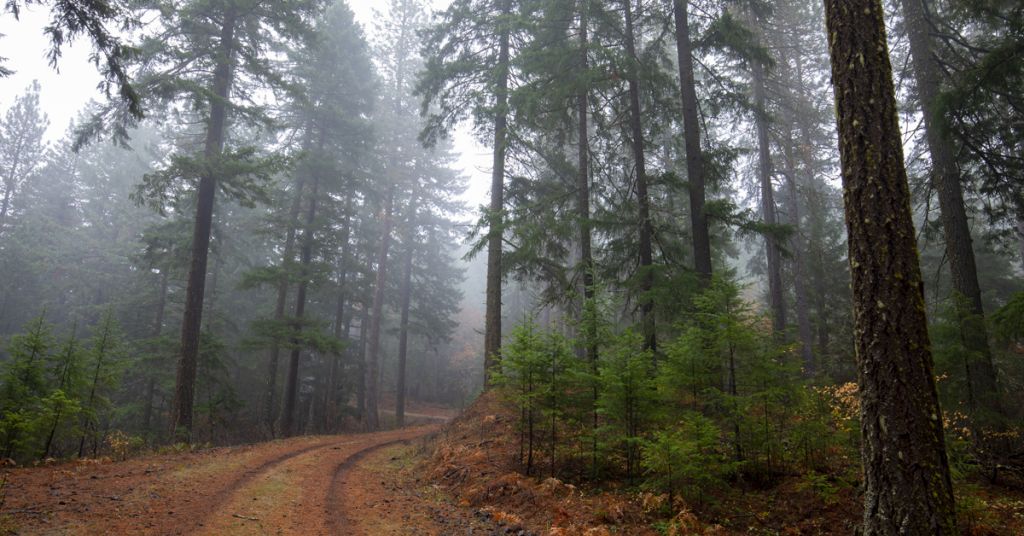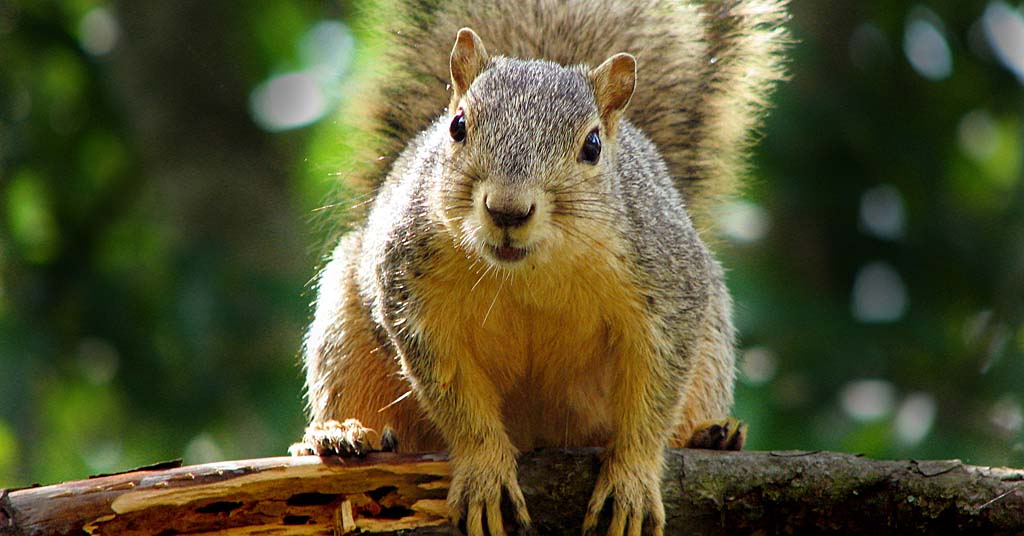A keystone species now limited to a few locations in the state, the fate of the squirrels may be decided in September

Good find: Western gray squirrels play a critical but diminishing role in Washington forests. Photo: Don Loarie/CC
UPDATE: On Feb. 23. 2024, the Vancouver Audubon Society, along with Friends of the Columbia Gorge, Friends of the White Salmon River, Center for Biological Diversity and Wildearth Guardians, filed a petition asking the Superior Court of the State of Washington for Clark County in Vancouver Audubon Society v. Washington DNR for a new case “involving a failure by the Washington Department of Natural Resources to propose critical habitat for the western gray squirrel.” According to the petitioners, the Washington Department of Natural Resources (DNR) is legally required to propose critical habitat for the western gray squirrel.
UPDATE: On Nov. 17, 2023, the Washington Fish and Wildlife Commission voted to uplist western gray squirrels from threatened to endangered under the state’s endangered species act. Population estimates for the squirrel range from 450 to 1,400 individuals. —Editor
By Bill Weiler, August 10, 2023. In Washington State, it’s designated a threatened species. In Oregon, you can kill three of them every day during the fall.
Never mind that it’s a keystone forest species—even in adjacent states, management of the western gray squirrel is at opposite ends of the spectrum.
Earlier this year, the Washington Department of Wildlife published a western gray squirrel status review in which it recommended up-listing the struggling species from “threatened” to “endangered” status.
WDFW’s rationales for making the change makes sense.
As the status review reports: “In a study of 10 timber harvest sites in Klickitat County, WDFW found the operators did not always implement all the recommended protection measures specifically in the timber harvest plans (FPAs). They concluded there was a strong need for improved implementation of habitat protection measures.”
An assessment of change in the availability of western gray squirrel primary habitat between 1993 (when the species was listed as threatened in Washington) and 2017 found gains from tree recruitment and tree growth did not compensate for habitat loss.
Estimated net loss of habitat totaled 20.8% for the North Cascades and 21.2% for the South Cascades.
Wildfire was the dominant disturbance in plots examined in the North Cascades, while timber harvest predominated in the South Cascades.
The rationale for up-listing is sound, but will decision-makers follow the science?
Keystone species
The western gray squirrel is a good-size, tree-abiding mammal—it’s the second largest squirrel in the United States—with a penchant for oak woodlands.
The gray, black and white-hued animal has a fascinating behavior of building a natal nest in a large oak hollow, before kicking pups out of the home and constructing a basketball-size (or larger) abode in a pine or fir.

Uncertain future:Pups are soon booted from their natal nests. Photo: WDFW
Despite its size, the nest can be easily missed by humans, as it’s camouflaged against the trunk or bole of the tree, typically two-thirds up the trunk.
Nests serves as a barometer of squirrel population numbers and habitat protection—but locating nests can be a challenge to loggers who are required to retain nest trees.
When I served as the local WDFW habitat biologist in southwestern Washington (1990-2009), western gray squirrel protection went beyond simply retaining the nest trees to include 50-foot, no-cut buffers and arboreal stringer connections to adjacent trees.
Formerly inhabiting all of western Washington into British Columbia, multiple challenges have greatly reduced western gray squirrels in Washington to include only Klickitat County, the U.S. Army Joint Base Lewis-McCord area near Olympia, and maybe, the few remaining un-charred forests in northern-central Okanogan County.
In addition to fire, threats include competition from at least three squirrel species, habitat loss from logging and development, climate change, a deadly disease called mange, an inability to safely cross roads and, no doubt, inadvertent bullets meant for other squirrels.
Some experts worry that wild turkeys out-compete western gray squirrels for similar food sources.
Meanwhile in Oregon
Along with Oregon Department of Fish & Wildlife staff, I spent three years (2019-2021) conducting the first western gray squirrel surveys in Wasco County, Oregon.
We surveyed state and federal forestlands.
Despite our grids covering premiere habitat, we confirmed only a small number of nests.
Even so, according to interim ODFW District Biologist Andrew Myers, it’s legal to hunt three western gray squirrels per day in northern Oregon counties for a 45-day hunting season each fall.
Myers told me that he hopes to determine western gray squirrel population trends in Wasco County through conducting “harvest surveys.”
Hunting western gray squirrels could be a severe limiting factor to growing a healthy, population, especially true when our nest survey team found numerous squirrels on private lands where hunting was prohibited.
Habitat being swallowed up
In 2022, the Conservation Fund purchased 35,000 of forested acres in southwestern Washington from the SDS Timber Company. It established four goals for the property:
- Retain oak trees, remove overtopping conifers
- Reduce fire risk
- Recoup purchase investment
- Protect western gray squirrel habitat
On July 19, 2023, along with 20 others, mostly folks in the timber industry, I participated in a Conservation Fund review of timber harvests in the hills above the town of Klickitat.
The tour showcased an active timber-harvest site.
A Conservation Fund scorecard showed that three of the organization’s four objectives were being met.
The exception was retaining western gray squirrel habitat through the retention of trees around nests and arboreal connectivity between nests.

Prime habitat: This logging road outside Trout Lake, Wash., runs through former timber land now owned by the Conservation Fund. Photo: @ianshivephoto/@tandemstock
A previous western gray squirrel conservation tour had resulted in the same assessment.
With timber harvest on Conservation Fund lands still in its beginning stage, perhaps the organization will be the first to demonstrate a logging prescription that leaves enough necessary forest structure for squirrels to continue utilizing the area.
The WDFW western gray squirrel status review states: “Core use areas have greater canopy cover, a greater number of trees species and trees with higher live crowns. Nesting areas are characterized by greater canopy cover, tree connectivity and dwarf mistletoe.”
These gray squirrel nesting components should receive the highest conservation priority, yet it is difficult to retain western gray squirrel habitat regardless of the timber-harvest prescription, especially when heavy-handed logging typically occurs on corporate private lands.
According to the status review: “Removal of over-story trees for commercial and non-commercial purposes occurred over large portions of the southern (Klickitat County area). Partial removal through thinning accounted for all harvest plots in the North, but
45% of harvested plots in the South were clear-cut.”
Western gray squirrels do not inhabit clear cuts.
According to Mary Linders, co-author of the WDFW status review and a WDFW research biologist who has worked with western gray squirrels since they were initially listed as threatened in 1993, the WDFW Commission will decide on the listing status of the squirrels during its September 2023 meeting.
In the meantime, WDFW staff is poring through the hundreds of publically submitted comments.
Will feds weigh in?
While the conservation community awaits the WDFW Commission’s decision regarding up-listing of the western gray squirrel, the Washington State Department of Natural Resources (DNR) Forest Practices Board will decide whether to enact regulations regarding western gray squirrel conservation.
Would endangered status for the western gray squirrel at long last force both WDFW and the Washington Department of Natural Resources (the agency that regulates and approves all logging on state and private lands) to finally enact regulations that would adequately protect the squirrels, their nests and suitable habitat?
Remarkably, the Forest Practices Board has never created rules for any state-listed species, depending solely on voluntary measures to conserve species at risk.
During the July field tour, I learned that after the rare ferruginous hawk was up-listed to endangered status by the WDFW Commission in 2021, the Forest Practices Board did not enact management regulations to protect the bird of prey.
Only when a species is both state listed and federally listed, as with the spotted owl, will the board act.
In 2003, the U.S. Fish & Wildlife Service rejected a petition to list the western gray squirrel as federally threatened. Will the federal agency be more amenable to doing so if the species is up-listed by Washington State next month?
No other wildlife species has the same critical bearing on sustainable forest practices in Klickitat County.
The sure sign of success regarding threatened, endangered or sensitive wildlife species is when its populations recovers and its distribution expands. Only then can it be safely removed from protective status.
The fact that WDFW has recommended up-listing the western gray squirrel to endangered means its habitat is decreasing, and the species and the state agencies responsible for its conservation management have been moving in the wrong direction.
The views expressed in this article belong solely to its author and do not reflect the opinions of anyone else associated with Columbia Insight.








Mr. Weiller, the gray squirrel is being threaten by large scale solar development in Klickitat County as we speak. Will you make a comment to EFSEC Energy Facility Site Evaluation Council of the threat solar development has to the gray squirrel in Klickitat County? Contact me Greg Wagner at cease2020@aol.com
Great article, Bill. On our 10A forested parcel in Hood River County, we have a few Western Squirrel nests and critters around, and we appreciate them. We also see Eastern Squirrels in the neighborhood, too. How weird that Oregon doesn’t cooperate on the hunting restrictions. FTF?
It is sad, we used to have WGS around our place but no more. Good article Bill.
Jurgen
My first reaction was that this is another “climate change” study substantiated by the Washington squirrel population patterns. Possibly my reaction was too hasty.
I live in Oregon’s central Willamette Valley and gray squirrels in this area seem to be everywhere I look, at least within city boundaries and white oak/doug fir foothills. I don’t know what a squirrel nest looks like but they are obviously reproducing effectively in this area. I can’t speak for dense fir forests since I spend little time in these areas. My wife is always after me to “do something” to keep the squirrels from eating her bulbs on the deck and around the yard. Local predators such as owls and coyotes are ineffective in managing the population.
Yes, Oregon does allow hunting of gray squirrels. Overhunting is obviously not a potential reason for Washington’s diminishing population. Maybe, the absence of hunting should be considered. Big game managers view hunting as one of the primary tools available to maintain sustainable populations. History has shown that when game populations (such as deer) are allowed to overpopulate, the result is often disease spreading throughout the herds resulting in a significant die-off of the population. Sports hunting is used to prevent that from happening.
Perhaps the State of Washington game managers should evaluate disease as a possible reason behind the population decline and possibly use hunting as a management tool.
Bill, thanks for spotlighting the WGS. Though maybe some light on a background story that’s indicative of just how difficult it is to save state-listed species, is apropos here. As you know, Under Canvas (UC), glamping’s poster child, has a Conditional Use Permit to operate a 95 canvas-walled resort (300+- guests, 40+- employees, 120 stall parking lot), perched above the White Salmon River between Husum (WSR) and BZ Corners, juxtaposed with the White Salmon National Scenic River. Klickitat county’s SEPA/CUP decisions have been under appeal and are now before the WA Court of Appeals—a decision is eminent. Appellants are local affected residents and KLPF, a land conservation non-profit which acquired property located near UC’s project site, in 1996, to conserve the WGS. Notwithstanding UC being the largest, most environmentally and socially disruptive development ever proposed along the WSR, no environmental groups are named in the court pleadings. Several groups wrote boiler-plate letters of opposition and SEPA comments to cover their back sides, but quickly faded. A letter of opposition signed by local/regional environmental organizations to a developer (hyper-sensitive over its image), may have helped, but none ever materialized. Potential adverse impacts to the WGS were an issue under appeal. Even though WGS and nests were observed on the proposed development site and the largest WGS nest concentration along the WS River occur on adjacent land, impacts to WGS are no longer under appeal. Why? The local WDFW habitat biologist ignored my plea to the agency to ask for an EIS in its SEPA comment to determine on-site/off-site WGS impacts, but instead met with the developer, then prescribed ineffective and unenforceable mitigation. Under Canvas ran with this “agency authority” all the way to the courthouse. Appellants’ attorney requested that a WDFW WGS expert be provided as a witness to the SEPA appeal but the request was refused. If UC becomes reality, the WGS will most likely abandon the resort property (120 ac) and adjacent /nearby lands, including KLPF land, over habitat fragmentation, disruption, and roadkill.
UC’s development site is located on former Weyerhaeuser land. This land was identified in the planning process that led to the WSNSR Management Plan and boundary area. The area’s mature conifer-oak forest provides quality habitat for many mature forest-dependent species, the WGS among them. The federal logging agency, the USFS, has utterly failed to implement the scenic river’s MP (See Columbia Insight, “United by a River, Divided over Management”, 11/28/19). These lands could have been acquired under the federal Land and Water Conservation Fund (LWCF) program to protect the WGS, but Portland-based enviros exert a heavy hand to ensure LWCF land acquisition funds go to the Gorge scenic area. As a result, the WSNSR and its wildlife are dying. The Columbia Gorge Audubon Society (CGAS) tried its best to head off the disaster now unfolding. CGAS’s public protest brought the agency and landowner together, but an interim acquisition entity was necessary. CGAS approached Western Rivers Conservancy, an interim acquisition entity. They looked at it but mostly gave the run-a-round. Indeed, Under Canvas would later assert in its PR campaign that land acquisition groups were not interested in acquiring the Weyerhaeuser property, but that it may donate a small piece of it to the USFS; a PR ploy to head off a negative “federal agency” SEPA comment. Concurrently, CGAS, at the recommendation of a Lewis and Clark law professor, Michael Blumm, co-author of “The Wild and Scenic Rivers Act 50: Overlooked Watershed Protection”, approached Advocates for The West, a public interest law firm, over suing the USFS for its failure to implement the WSNSR MP. Even though Blumm suggested a petition be filed, Advocates decided against it, as it was thought, in part, that winning in the conservative eastern district federal court was risky. Loss of the river-associated Weyerhaeuser lands to resorts and residential development, coupled with the SDS liquidation, where The Conservation Fund failed to acquire 800 acres of WSNSR boundary lands that were planned to be acquired by the USFS, sealed the fate of the last best hope to save the White Salmon River WGS population. To rub salt in the wound, UC and The Nature Conservancy recently hitched up for a little greenwashing. I wrote a letter to the Conservancy asking that it steer its partner away from sites impacting listed species. No response! Cowboy capitalism-driven, misguided, centralized, publicly subsidized, wind/solar/pump storage development and residential land speculation is crushing Klickitat County–the most biologically diverse of the Gorge counties. Uplisting the WGS, if it happens, is most likely too little, too late. Dennis White
Thank you Dennis. I do believe your UC appeal will carry more weight if the gray squirrel is listed as endangered. Hopefully too, an uplisting would make the feds consider a federal listing.